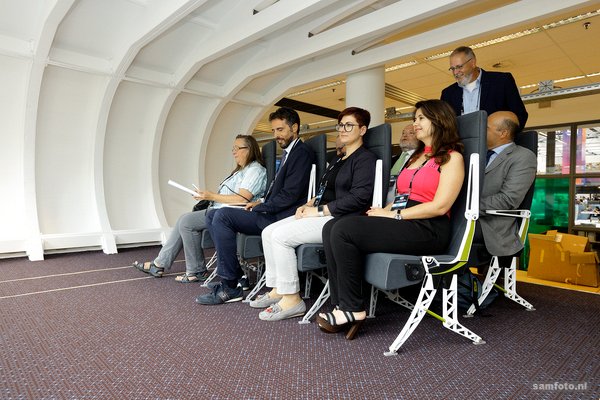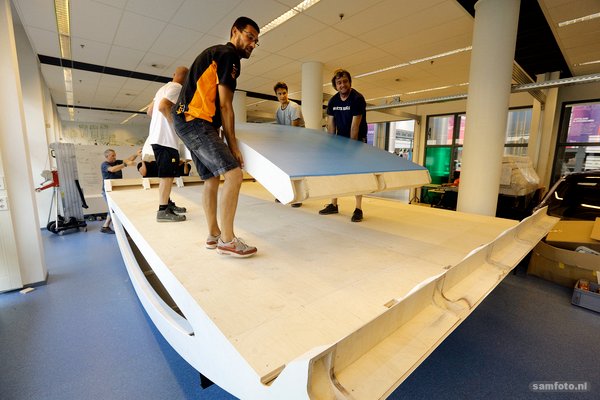Will the Flying-V get off the ground?
Reseachers at the faculties of AE and IDE are working on a new type of aircraft; the Flying-V. This tailless plane integrates the cabin, cargo hold and fuel tanks in the wing. Just how feasible is the design?
Spending hours doubled up in an economy class seat leaves even the most enthusiastic traveller jaded. It’s time to lie down on a real bed. Or why not enjoy a drink at the bar, or get a snack from the buffet? TU Delft IDE researchers think this luxury could be available for economy-class passengers. That is, if the Flying-V gets off the ground. The design, with the cabin, cargo hold and fuel tanks integrated in the wing, is radically new in commercial passenger aviation. The entire aircraft is in fact a single V-shaped wing.
TU Delft has been working for some years on this project. For a long time, it seemed the project would never get off the drawing board but, this spring, KLM decided to invest in it. Project manager Roelof Vos (Aerospace Engineering) is unwilling to say how much. “It’s a helping hand financially. Thus far, this has purely been a student research project on paper, now we also have the means to engage technicians to build a scale model.”
This month a section of the fuselage (the interior) of this ‘aircraft of the future’ will be on display during the KLM Experience Days, which are being held to mark the 100th anniversary of KLM. The Experience Days will also feature a radio-controlled scale model of the Flying-V, with a wingspan of 3 metres and a length of 2.5 metres (scale 1:20).
Folding seats
The cabin interior with its two rows of four seats was on show in August during the International Comfort Congress in the faculty building of Industrial Design Engineering. Thomas Rotte, a member of the Flying-V project team, explains some of the innovations in the cabin:
“The seats are not in straight rows like a traditional aircraft, but are staggered to create extra leg and shoulder room. As the aircraft is V-shaped and the longitudinal direction of the fuselage is not the direction of flight, the staggering of the seats creates no extra wasted space. And coincidentally it allows us to put the seats precisely in the direction of flight.”
Another nice detail: the seats can be folded. “This makes the boarding process much easier. It is easier to get in and out of the row, even with hand baggage, reducing congestion in the aisle. Another advantage is that children can sit more comfortably on the folded up seat, and it allows adults to change position should they wish to stretch their legs.”
It took the congress visitors some time to get used to the design. “OK, it is more spacious. But there’s also less privacy”, said a lady in the second row. “The staggered seats mean I’m sitting diagonally across from my neighbour and can easily see his tablet screen.” Her neighbour in turn
was surprised that the seats are not parallel to the walls of the fuselage. “Won’t this mean we all get airsick? We’re not sitting in the direction of flight.” But of course they are sitting in this direction, due to the aircraft's V shape.
Privacy
PhD candidate Meng Li, of the Applied Ergonomics and Design research group, has thought of a solution to the privacy problem. See sees the passengers of the future being able to screen themselves off from other passengers using a hood on the armrest that you can pull out to shoulder height and which contains a TV screen so you can watch films undisturbed during the flight. The hood itself is transparent, but can be darkened using a simple sliding mechanism. In addition to the extra comfort provided by the extra leg room and gadgets, the aircraft is fitted with beds. Project team member Rotte says there is room between the ribs, which reinforce the hull, for bunk beds on the inner side of the aircraft (towards the point of the V).
The beds were not ready in time for the congress. “It proved really tricky to create bunk beds that you can also transform into seats”, Rotte explains. “And that’s a vital requirement as all passengers need to be seated with seatbelts on for take-off and landing. We have come up with a system for this, which we will be patenting, but until the patents are granted we won't be showing the system.”
The aircraft will also have some areas where you can sit with four people facing each other, like in trains. And there will be lounge chairs that fully recline. These seats are also placed in a staggered formation to save space, but then vertically. This means that when reclined, the legs of the rear passenger are half under the seat in front.
The question remains of how the cabin crew can bring round the meals and drinks. With four seats in a row, it is no longer possible to reach across to the furthest passenger in the window seat, let alone if the rows are even longer. Rotte thinks the meal and drinks service may need to be revised. “The seating configuration where the two wings converge is problematic as you get passenger flows from both wings. So it’s not very handy to put seats there, but it might be just the place to put a buffet.”
Our aircraft can be easily lengthened or shortened. This is needed for a new type of aircraft to be profitable. This was not possible in blended-wing designs until now
Blended wing-concept
Back in time. Since the 1950s, designers have been working to improve jet aircraft with their distinctive cigar-shaped fuselage. Since they conquered the skies, they have become more energy-efficient and quieter, but the limits have now been reached. To gain even more efficiency, aircraft manufacturers need to switch to a radical new design.
Aircraft where the wings and fuselage are integrated in a blended-wing body are far more aerodynamic. The military has been using this design since as far back as the 1940s; an example is the American Northrop YB-49, which first took to the skies in 1947. The Flying-V closely resembles this design, except for its cargo: the Northrop carried bombs, not passengers. Commercial passenger aviation has so far resisted the blended wing. The Delft researchers hope to change this.
AE project leader Roelof Vos explains that this design differs from the old blended-wing concept on a crucial point. “Our aircraft can be easily lengthened or shortened. This is needed for a new type of aircraft to be profitable. This was not possible in blended-wing designs until now.”
The TU Delft engineers are building on a patent from Airbus. In 2014, a student at TU Berlin, who was doing a traineeship at Airbus, stuck two A320 fuselages together in a V-shaped wing on the drawing board and made the whole thing more streamlined. He added an extra two small wings to the tips. Airbus saw the potential and patented the design.
Vos was intrigued. “With a healthily critical academic attitude, we started an independent study. We made calculations and adjusted the shape.”
The more aerodynamic shape and lower weight of this aircraft means it should use twenty percent less fuel than the Airbus A350, which serves as a reference. The Flying-V should be able to carry the same number of passengers (314) as the A350 and the same volume of cargo (160m3).
The Flying-V is shorter than the A350, but has the same wingspan. This means it should have no problems using the existing infrastructure at airports, such as gates and taxiways, and it fits in the same hangar as the A350. However, even if the project continues, it will be a long time before a plane like this actually carries passengers. “Passengers will have to wait until 2040 at the earliest”, says Vos.
Just before this magazine went to press, work was continuing on the radio-controlled model of the plane. Researcher Malcom Brown (AE) showed us around the workshop where he is assembling the plane step-by-step, using a robot arm that knows the precise position of every part. “Soon we will be gluing the top and bottom of the fuselage together, then we won't be able to get to anything, so all the electronics need to work perfectly.”
Brown sees stability as an enormous challenge for the plane. “In a traditional aircraft, the rudder is right at the back, in the tail. Our model has to be steered by the wings. That's a lot more tricky.”
Will the plane have flown before it is displayed at Schiphol? Brown can't say for sure. “It certainly won't be flying when it's on show at Schiphol. That would be too dangerous.”
G forces
The technology website arstechnica.com has been critical of the Flying-V project, saying that passengers will feel like they're on a roller coaster. Because passengers are seated far from the centre line of the plane, they will experience higher G forces when the plane turns. This will particularly affect economy-class passengers as they are seated further back and at the sides.
Vos thinks it will not be too bad. “Airbus has already done some research on this aspect, putting people in a simulator. Passengers had no problems up to 11 or 12 metres from the centre line. We’re keeping within this distance.”
An important issue is how quickly passengers can exit the plane in an emergency. All passengers need to be out of the plane within 90 seconds, but there are only half the usual number of emergency exits. “We still need to test this”, says Vos. “We don’t need the real plane for this; we can experiment using test subjects in a mock-up space with the same format. We may have to make changes to the design to comply with the evacuation requirements, but I don't anticipate this being a show stopper.”


